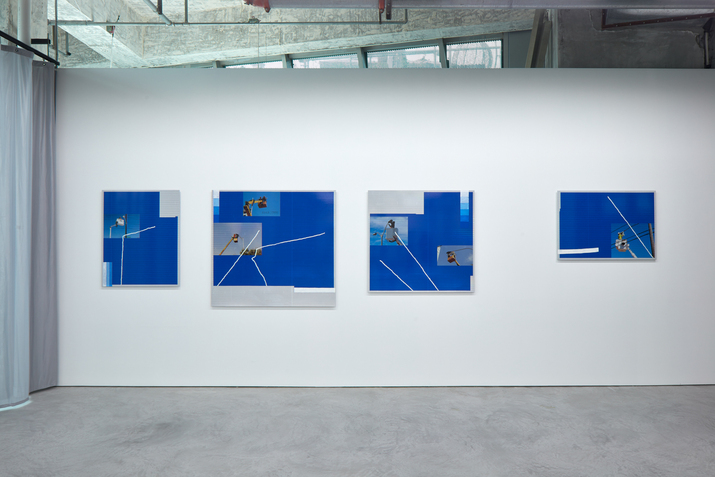-
From Current Issue
-
- Editor’s Letter Fire in the Heart
- Reviews I Gusti Ayu Kadek Murniasih
- Reviews 11th Seoul Mediacity Biennale: “One Escape at a Time”
- Dispatch Networked China
- One on One Monira Al Qadiri on Yukio Mishima
- Essays The rise of independent art spaces in pandemic-era Shanghai
- Features Tuan Andrew Nguyen
- Table of Contents
- Web Exclusives
- Archive
- Subscribe

R
E
V N
E
X
T
Installation view of WANG WEI and KO SIN TUNG’s "Muse for a Mimeticist” at Edouard Malingue Gallery, Shanghai, 2017. Photo by Zhang Hong. Courtesy Edouard Malingue Gallery.
Curators of group shows regularly describe particular selections of works as creating a metaphorical dialog within their space. But at Edouard Malingue Gallery’s most recent exhibition, “Muse for a Mimeticist,” a literal dialog between artists Ko Sin Tung and Wang Wei led to the latter’s striking centerpiece for the show—a 16-meter-long mosaic—which faithfully mirrored a work by his Hong Kong-born co-exhibitor. The attention to detail of this hyper-site-specific piece matches Ko’s own obsessive unpicking of the visual data that informs how we experience reality. By zooming in and out of elements of the world around us, the pair draw lines of connection to convey minutiae of our day-to-day.
In art, mimeticism is the pursuit of absolute perfection in representation—in other words, it is art imitating life. In Greek antiquity, artists Zeuxis and Parrhasius held a painting contest to determine who was the better artist. When Zeuxis unveiled his uncannily realistic painting of grapes, even birds were duped into pecking at his canvas. Not to be outdone, Parrhasius led his opponent to his painting of a curtain, only for Zeuxis to demand he open it. Two-one, Parrhasius.
WANG WEI, What You See is Not What You See, 2017, mosaic tiles, 1650.5 × 330 cm. Courtesy the artist and Edouard Malingue Gallery, Shanghai.
In contrast, Wang and Ko zero in on particular elements of their surroundings, accentuating the very data of what we see to intriguing effect. Returning to the mosaic medium after successful showcases at Cass Sculpture Foundation in 2016, and more recently in a hands-down highlight of the “Encounters” series at this year’s Art Basel Hong Kong, Wang’s What You See is Not What You See (2017) is a mirror image of the gallery space. It depicts the gallery’s signature industrial-looking pipes and vents, spotlights bouncing off of metal beams, and the Huangpu River outside. Rooting the mosaic firmly in time and space are specific details such as four steel-framed chairs, and Ko’s Sunflower and Safety Helmet (2017), which is positioned diametrically opposite the tiled work.
Wang’s mosaic was realized and installed in just one month: after “pixelating” a photograph of the space in Photoshop, the artist commissioned a factory in southern China’s manufacturing hub of Dongguan to create “slabs” of square tiles each with sides measuring 30 centimeters. A simplified, streamlined reflection of reality, it uses just a handful of colors and a necessarily linear style. In keeping with artist’s ongoing investigation of physical space, the mosaic appears surprisingly fluid, and its depicted scene seemingly moves across its 16-meter length.
Reflected in Wang’s tiled work is Ko’s Sunflower and Safety Helmet, a digital print of overlapping, internet-sourced images. Peppering the prints are CMYK codes picking out and identifying precise shades of vibrant yellow, succinctly establishing commonality between these two apparently disparate things.
Also by Ko, an adjacent series of aluminum boards digitally printed with internet-sourced imagery is explicitly titled One day, workers replaced the traditional high pressure sodium street lights with the new LED ones (2017). Similarly concerned with summarizing sights—roads, in this case—to their most rudimentary, arms of street lights and cranes are painted in thin white lines on top of the prints. They look a lot like fixtures drawn in stick-figure style. Some feature swatches of blue paint, the hues plucked from blue sky backdrops like a kind of manual Photoshop color picker, a tool regularly used to replicate, represent and enhance reality.
Strata of color and light are also central to Ko’s double-channel video, The World of Yesterday (2017). Initially playing in sync across both screens, the film opens with an innocuous image lifted from Wikipedia’s page about 1080-pixel high definition. The shot is dissected into three segments—full HD, 720 pixels (in blue) and 576 pixels (in red). On diverging into fractions of red and blue respectively, the screens tackle different elements of how we experience our surroundings. Red concerns environment: how the artist’s cat commands its particular domain, and how the view from an apartment window impacts perception of what lies out of eyeshot. Blue denotes time, memory and nostalgia. A nod at once toward the evolution of our own understanding of light and vision, and also the multiple factors and forces that shape experience, it successfully breaks down not just what we see, but how we encounter, interpret and feel.
Each one obsessive in unpicking details of specific spaces, together, Wang and Ko peel back layers of seeing. From the dimensional to the sensory, they address individual constituents that form the basis of our processing of environments. True and accurate in the most literal of ways, their works also proffer an alternative means of experience, right down to the most changeable element of all: each other.
Wang Wei and Ko Sin Tung’s “Muse for a Mimeticist” is on view at Edouard Malingue Gallery, Shanghai, until August 20, 2017.
To read more of ArtAsiaPacific’s articles, visit our Digital Library.








